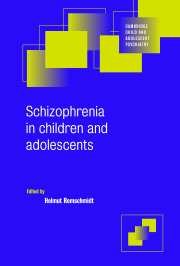Book contents
- Frontmatter
- Contents
- List of contributors
- Preface
- 1 Childhood psychosis and schizophrenia: a historical review
- 2 Definition and classification
- 3 Epidemiology of early onset schizophrenia
- 4 Childhood schizophrenia: developmental aspects
- 5 Diagnosis and differential diagnosis
- 6 Genetic aspects
- 7 Neurobehavioral perspective
- 8 Psychosocial factors: the social context of child and adolescent onset schizophrenia
- 9 Treatment and rehabilitation
- 10 Course and prognosis
- Index
2 - Definition and classification
Published online by Cambridge University Press: 23 October 2009
- Frontmatter
- Contents
- List of contributors
- Preface
- 1 Childhood psychosis and schizophrenia: a historical review
- 2 Definition and classification
- 3 Epidemiology of early onset schizophrenia
- 4 Childhood schizophrenia: developmental aspects
- 5 Diagnosis and differential diagnosis
- 6 Genetic aspects
- 7 Neurobehavioral perspective
- 8 Psychosocial factors: the social context of child and adolescent onset schizophrenia
- 9 Treatment and rehabilitation
- 10 Course and prognosis
- Index
Summary
Introduction
Schizophrenic psychoses in childhood are important but rare disorders within the spectrum of psychoses. They were delineated as specific psychotic disorders only in the late 1930s (Lutz, 1937/38). By the 1950s and 1960s, it was evident that age and developmental stage were important criteria for the classification of childhood psychoses (Group for the Advancement of Psychiatry, 1966; Stutte, 1969). Their importance was demonstrated by several empirical studies (Rutter & Lockyer, 1967; Rutter et al., 1967; Kolvin, 1971; Kolvin et al., 1971a,b,c,d,e). Finally, these studies confirmed the notion of Kanner (1943, 1957), who subdivided childhood psychoses into three groups: early infantile autism, childhood schizophrenia, and disintegrative psychoses of childhood. Disintegrative psychoses comprise disorders such as dementia infantilis (Heller, 1908) and psychoses related to different kinds of brain damage. These subdivisions have also influenced the multiaxial classification systems of the International Classification of Diseases on the basis of ICD-9 and ICD-10 (WHO, 1992) and the Diagnostic and Statistical Manual of Mental Disorders of the American Psychiatric Association (DSM-III-R and DSM-IV) (APA, 1987, 1994). Both DSM and ICD differentiate between childhood autism (ICD-10) resp. autistic disorder (DSM-IV), childhood schizophrenia, and early childhood dementia subsumed under the headline “Other childhood disintegrative disorder” resp. “Childhood disintegrative disorder” (DSM-IV).
Early descriptions
Hermann Emminghaus (1887) wrote the first textbook on child psychiatry, Psychic Disturbances of Childhood. This text described childhood psychosis as “cerebral neurasthenia” and defined this disorder as “neurosis of the brain characterized by a reduction of cognitive (intellectual) abilities, mood changes, sleep disturbances and manifold anomalies of innervation with a subacute or chronic course and different states of outcome” (p. 134).
Keywords
- Type
- Chapter
- Information
- Schizophrenia in Children and Adolescents , pp. 24 - 42Publisher: Cambridge University PressPrint publication year: 2000



